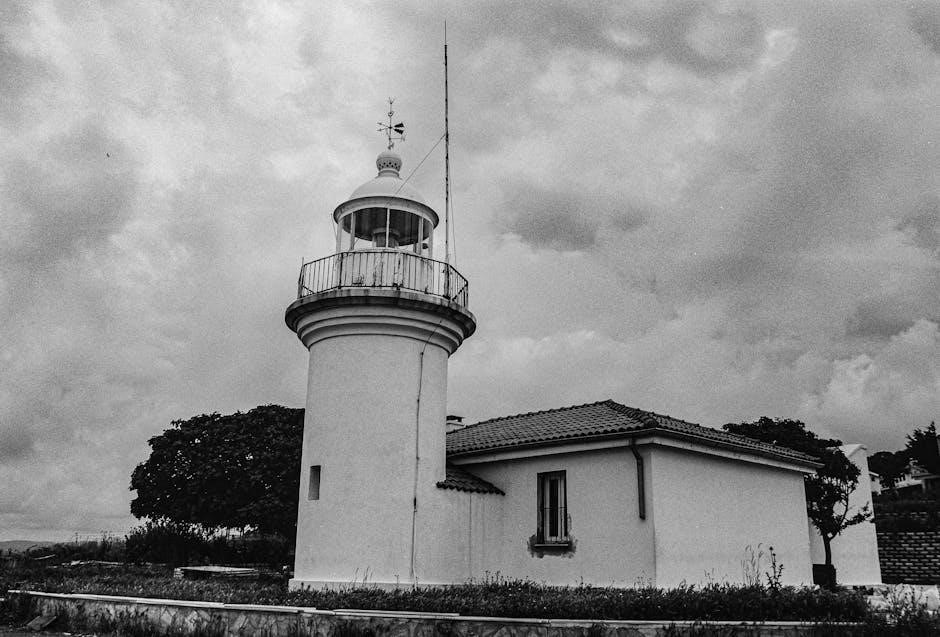
The Nikon D50 is a lightweight, compact DSLR camera designed for both beginners and photography enthusiasts. Featuring a 6.1 MP DX-format CCD sensor, it captures vibrant images with sharp details. Its intuitive design and advanced features make it an excellent choice for learning and creative photography.
Key Features of the Nikon D50
The Nikon D50 is a feature-rich DSLR camera designed to deliver high-quality images with ease. It boasts a 6.1-megapixel DX-format CCD sensor, capturing vibrant colors and sharp details. The camera features a 5-area autofocus system for precise and fast subject acquisition, ensuring crisp results even in dynamic situations. With an ISO range of 200 to 1600, the D50 performs well in various lighting conditions, allowing for flexibility in both indoor and outdoor photography. Its lightweight and ergonomic design makes it comfortable to carry and use, while the 2-inch LCD screen provides a clear view for reviewing images. The D50 also supports continuous shooting at 2.5 frames per second, making it suitable for action photography. Additionally, it uses SD memory cards for storage and is compatible with a wide range of Nikon lenses and accessories, offering versatility for photographers of all levels. The camera’s battery life is impressive, with the EN-EL3a battery providing up to 400 shots per charge, making it ideal for extended shooting sessions. These features combine to make the Nikon D50 a powerful and user-friendly tool for capturing stunning photographs.

Shooting Modes Explained
The Nikon D50 offers a variety of shooting modes to suit different photography needs. Auto Mode is ideal for beginners, automatically adjusting settings for point-and-shoot simplicity. Portrait Mode prioritizes shallow depth of field to blur backgrounds and emphasize subjects, while Landscape Mode ensures sharp focus across the entire frame for scenic shots. Sports Mode is designed for capturing fast-moving subjects with rapid autofocus and continuous shooting. Close-up Mode is perfect for macro photography, focusing on fine details. Night Portrait Mode balances flash with ambient light for evening portraits. Manual Mode (M) allows full control over aperture, shutter speed, and ISO for advanced users. Aperture Priority (A) and Shutter Priority (S) modes offer partial manual control, letting users adjust aperture or shutter speed while the camera adjusts the other. These modes provide flexibility and creativity, catering to both casual and professional photographers. Each mode is easily accessible via the camera’s intuitive interface, making it simple to adapt to any shooting situation.

Understanding ISO Settings and White Balance
ISO settings on the Nikon D50 determine the camera’s sensitivity to light, ranging from ISO 100 to 1600. Lower ISO values (e.g., 100 or 200) are ideal for bright lighting conditions, producing sharp, noise-free images. Higher ISOs (e.g., 800 or 1600) are better for low-light situations but may introduce grain or noise. The D50 performs well at high ISOs, making it versatile for various lighting conditions.
White Balance adjusts the color temperature of images to match the lighting source, ensuring accurate colors. The D50 offers presets like Auto, Daylight, Shade, Tungsten, and Fluorescent, as well as a Manual option for custom settings. Using the correct White Balance prevents unwanted color casts and enhances image quality.
For optimal results, use ISO 1600 sparingly and prefer sharp, grainy images over blurry ones. White Balance can be set automatically or manually, with options like the 81A filter for warmer tones. These features empower photographers to control image aesthetics effectively.
Navigating the Menu System
The Nikon D50 features an intuitive menu system designed to simplify camera operation. Access the menu by pressing the MENU button located on the rear of the camera. The menu is divided into clear sections, starting with basic settings for beginners and advancing to more complex options for experienced photographers.
Navigation is straightforward, using the multi-selector button to scroll through options and the OK button to select. The Zoom In and Zoom Out buttons can also be used to adjust settings efficiently. Customization is a key feature, with options to save frequently used settings in the My Menu section.
The menu includes options for image quality, ISO, white balance, autofocus, and more. Users can also access the Setup Menu to configure camera defaults and maintenance settings. Tips like using the Help button for guidance and organizing settings for quick access enhance the user experience. This system ensures photographers can easily tailor the D50 to their preferences, making it a versatile tool for creative photography.
Troubleshooting Common Issues
The Nikon D50, like any camera, may encounter issues that can be resolved with simple troubleshooting. One common problem is the camera not turning on, which can often be fixed by checking the battery level or ensuring the power button is functioning properly. If the camera fails to focus, try cleaning the lens or resetting autofocus settings.
Memory card errors are another frequent issue; formatting the card in the camera or using a different card can resolve this. For blurry images, check if the lens is dirty or if the autofocus is set correctly. If the camera overheats, allow it to cool down before continuing use.
The Setup Menu offers tools to reset camera settings to default, which can resolve unexpected behavior. Additionally, updating firmware or cleaning the sensor and lens regularly can prevent many issues. Consulting the user manual or online resources provides detailed solutions for specific problems, ensuring optimal performance.

Maintaining Your Nikon D50
Proper maintenance is essential to ensure your Nikon D50 performs optimally and lasts for years. Regularly clean the camera’s sensor and lens using a soft brush or microfiber cloth to remove dust and smudges. For deeper cleaning, use a lint-free cloth with a small amount of lens cleaning solution.
The battery and memory cards also require attention. Clean the battery terminals with a soft cloth to maintain proper power flow. Format memory cards regularly within the camera to prevent errors and ensure compatibility.
Store the camera in a dry, cool place, away from direct sunlight and moisture. Use a protective case or bag to shield it from dust and physical damage. Avoid extreme temperatures, as they can affect the camera’s performance and longevity.
For optimal functionality, update the camera’s firmware periodically using Nikon’s official software. This ensures you have the latest features and improvements. Additionally, consider using a UV filter on the lens to protect it from scratches and reduce glare.
Finally, have your Nikon D50 serviced professionally every 1-2 years to clean the sensor and internal components. This proactive approach will help maintain image quality and extend the life of your camera.
Essential Accessories for the Nikon D50
To enhance your photography experience with the Nikon D50, consider investing in key accessories. A high-capacity memory card, such as a 2GB or larger SD card, ensures you can store plenty of images. The EN-EL3a battery provides reliable power, but having a spare battery and a charger is wise for extended shoots.
A sturdy tripod is indispensable for stabilizing the camera, especially in low-light conditions, and helps prevent camera shake. A protective camera bag or case safeguards your equipment during travel. Additional lenses, like the AF-S DX NIKKOR 18-55mm f/3.5-5.6G ED or the AF-P DX NIKKOR 70-300mm f/4.5-6.3 VR, expand your creative possibilities.
A UV filter protects the lens from scratches and reduces glare, while a polarizing filter enhances colors and contrast. For remote shooting, the ML-L3 wireless remote control is handy. Lastly, the Nikon Transfer software simplifies image transfer and management. These accessories ensure you’re well-equipped to capture stunning photos with your Nikon D50.

Advanced Photography Techniques
To take your photography to the next level with the Nikon D50, explore advanced techniques that maximize its capabilities. Manual focus allows precise control over your subject, especially useful for macro or portrait shots. Experiment with lens choices, such as wide-angle lenses for landscapes or telephoto lenses for distant subjects, to add creativity to your compositions.
Bracketing is a powerful tool for capturing high-contrast scenes. By shooting multiple exposures at different settings, you can later merge them using HDR software for stunning results. Additionally, the D50’s built-in flash can be used creatively for fill lighting or bounced off surfaces for softer, more natural illumination.
For low-light photography, the D50 excels at higher ISOs, producing sharp images with minimal noise. Try using slow shutter speeds to capture motion blur, adding dynamism to your shots. Lastly, experiment with custom white balance to achieve accurate colors in challenging lighting conditions. By mastering these techniques, you can unlock the full potential of your Nikon D50 and produce professional-quality images.
The Nikon D50 is an excellent DSLR camera for both beginners and enthusiasts, offering a perfect balance of simplicity and advanced features. By mastering its controls and understanding the techniques outlined in this guide, you can unlock its full potential and capture stunning images. Always remember to read the user manual thoroughly, as it provides detailed insights into the camera’s functionality and hidden features.
For optimal results, experiment with different shooting modes, ISO settings, and white balance options to adapt to various lighting conditions. Regularly clean the sensor and lenses to maintain image quality, and consider investing in essential accessories like additional lenses or external flash units to expand your creative possibilities.
Finally, practice is key! The more you use the Nikon D50, the more familiar you’ll become with its capabilities. Don’t hesitate to explore online resources or join photography communities for additional tips and inspiration. With dedication and practice, you’ll take your photography to new heights with the Nikon D50. Happy shooting!